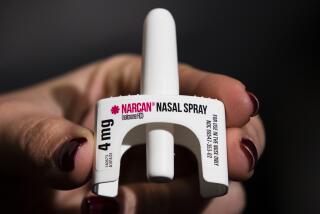Not right for everyone
- Share via
WHEN coronary arteries grow dangerously narrow, the solution — increasingly — is to prop open the walls with a device called a drug-eluting stent. Now two new studies are adding fuel to a growing debate about whether these stents are being overused, with ill consequences for patients.
The studies, both published in the May 9 issue of the Journal of the American Medical Assn., included large groups of patients who were treated for narrowing in their coronary arteries with the stents, which are tiny drug-coated cylinders used to prop open blocked arteries.
The drugs are released over time and help prevent blockages from scarring that occurred in 20% of patients following treatment with an earlier generation of bare metal stents. Coated stents have largely replaced the older bare-metal ones and are now carried around in the chest cavities of some 4 million Americans.
Both studies found that the coated stents worked best in the kinds of patients for whom the device was approved by the Food and Drug Administration: people with short, single areas of narrowing in the arteries, who had no blood clots and had not suffered a heart attack.
But many of the patients examined in the study were sicker, more complicated heart patients, and there the results differed — with one study finding a tenfold greater rate of complications in the sicker group than the second study did.
The use of medical devices in the real world often bears little resemblance to the use for which they were originally approved. After approval, physicians are free to use the device on just about anyone — “off label” use. And in this case, they’ve done so with vigor.
The stent industry sells about $3.2 billion worth of the devices annually in the United States, and about half of the 1 million procedures performed each year are done on more complicated patients than were studied for FDA approval.
The studies both found that, after a year, patients getting the stents for off-label indications had greater risks from the devices than the less seriously ill patients for whom the devices were approved.
But then the results diverged.
The first study, funded in part by Cordis Corp., a medical device corporation that manufactures stents, found the risks of bad outcomes, such as re-narrowing of arteries (restenosis), heart attack or death, was relatively small. Rates of restenosis were about 7% to 8% in the off-label group, slightly higher than the 5% seen with on-label patients and a lot lower than the 20% seen with bare metal stents. “We’re still at about one-third that rate,” says Dr. Charles Davidson, professor of medicine at Northwestern University and a coauthor of that study.
The other study, funded in part by Millennium Pharmaceuticals and Schering Plough Inc., which make cardiac drug alternatives to the implanted devices, had a more dire reading of off-label use of the devices.
In that study, the risk of the artery again narrowing after a year was 17%, or 390 people, in patients who received the stents off label, compared with 9%, or 131, people who were less sick.
Though that’s still slightly better than the old bare-metal stents, sicker patients need to be told that, for them, the risks are likely higher than original studies indicate, says Dr. Neal S. Kleiman, director of the cardiac catheterization laboratory at the Methodist DeBakey Heart Center in Houston, and co-author of the second study.
“The risks are higher, about 2 1/2 times as high, in more complex patients,” Kleiman says.
The different results could have to do with the way that the two studies collected their data, says Dr. Robert A. Harrington, director of the Duke University clinical research unit, who coauthored a commentary accompanying the studies. And this difference might, he says, have been influenced by each study’s source of funding.
The two studies worked from the same registry of patients, one looking at records of about 3,000 patients while the other looked at those of about 5,000 patients. But they didn’t examine the data in the same way to see how the patients had fared. The pharmaceutical industry-sponsored study scoured patient records for any sign of clots, while the other study didn’t. The device-sponsored study made no mention of how they looked for evidence of heart attack.
The two studies form a cautionary tale. “It’s a call to come up with common ways to collect information in similar studies,” Harrington says.
Harrington says he thinks that drug-coated stents are being overused, and that more heart patients should talk with their doctors about other treatment options, such as cardiac bypass surgery or treatment with drugs.
“What happened with stents is that things really got ahead of themselves,” he says. “We had good data on low-risk patients. But very quickly, we started putting these devices in virtually everybody.”
For consumers, he says, “Ask your doctor: Why are you doing this? Upon what body of evidence are you basing your decision? What are the medical alternatives?”
*
susan.brink@latimes.com






